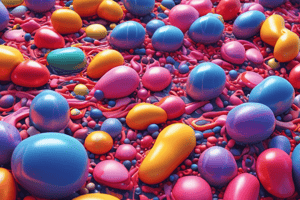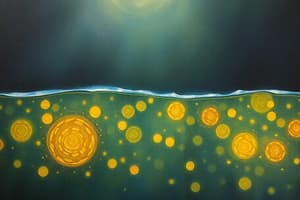Podcast
Questions and Answers
Cholesterol plays a role in controlling fluidity and adding sturdiness to the membrane.
Cholesterol plays a role in controlling fluidity and adding sturdiness to the membrane.
True (A)
Sobrang titigas yung bilayer when there is too little cholesterol present.
Sobrang titigas yung bilayer when there is too little cholesterol present.
False (B)
Membrane Lipids are unipathic, consisting of 1 polar head and 2 nonpolar tails.
Membrane Lipids are unipathic, consisting of 1 polar head and 2 nonpolar tails.
False (B)
The hydrophobic part of a membrane lipid is composed of hydrocarbons.
The hydrophobic part of a membrane lipid is composed of hydrocarbons.
Peripheral proteins are attached to both sides of the lipid bilayer.
Peripheral proteins are attached to both sides of the lipid bilayer.
Receptors on cell membranes can only interact with ligands and not viruses or bacteria.
Receptors on cell membranes can only interact with ligands and not viruses or bacteria.
The specific heat of water is 1.0 calorie per gram, which is lower than other liquids.
The specific heat of water is 1.0 calorie per gram, which is lower than other liquids.
If the temperature of water changes rapidly, it can lead to climate change, flooding, and typhoons.
If the temperature of water changes rapidly, it can lead to climate change, flooding, and typhoons.
When we sweat, the warmer layer on top of the skin has high heat energy.
When we sweat, the warmer layer on top of the skin has high heat energy.
Water's high heat of vaporization means it vaporizes quickly compared to other liquids.
Water's high heat of vaporization means it vaporizes quickly compared to other liquids.
The cohesive behavior of water is due to its extensive network of hydrogen bonded molecules.
The cohesive behavior of water is due to its extensive network of hydrogen bonded molecules.
If you immerse a stem with flowers in colored dye, the color of the flower will not change after 10 minutes.
If you immerse a stem with flowers in colored dye, the color of the flower will not change after 10 minutes.
A single carbon atom is conductive and can conduct electricity.
A single carbon atom is conductive and can conduct electricity.
Bucky balls, which are made up of many carbons grouped together, were synthesized more than 2 decades ago.
Bucky balls, which are made up of many carbons grouped together, were synthesized more than 2 decades ago.
The octet rule states that an atom is stable when it has 6 electrons in its outermost shell.
The octet rule states that an atom is stable when it has 6 electrons in its outermost shell.
In H2O, the unequal sharing of electrons results in hydrogen having a partial negative charge.
In H2O, the unequal sharing of electrons results in hydrogen having a partial negative charge.
Carbon is considered stable when it has 8 electrons in its outermost shell.
Carbon is considered stable when it has 8 electrons in its outermost shell.
Direction of arrows pointing towards oxygen in a molecule indicate polarity because oxygen is less electronegative.
Direction of arrows pointing towards oxygen in a molecule indicate polarity because oxygen is less electronegative.
Valence is defined as the number of electrons needed to make an atom stable and complete the 8 electrons in the outermost shell, following the octet rule.
Valence is defined as the number of electrons needed to make an atom stable and complete the 8 electrons in the outermost shell, following the octet rule.
Chitin, a fibrous substance in arthropod exoskeletons, is made up of monosaccharides.
Chitin, a fibrous substance in arthropod exoskeletons, is made up of monosaccharides.
Cellulose, found in plant cell walls, is made up of long chains of glucose molecules connected by ionic bonds.
Cellulose, found in plant cell walls, is made up of long chains of glucose molecules connected by ionic bonds.
Humans can digest cellulosic material easily due to the presence of specific enzymes.
Humans can digest cellulosic material easily due to the presence of specific enzymes.
Researchers have studied termites because they are interested in their ability to produce bioethanol.
Researchers have studied termites because they are interested in their ability to produce bioethanol.
The primary structure of proteins becomes functional as soon as it is synthesized.
The primary structure of proteins becomes functional as soon as it is synthesized.
Lipids are different from other macromolecules because they consist of repeating subunits like proteins and nucleic acids.
Lipids are different from other macromolecules because they consist of repeating subunits like proteins and nucleic acids.
Most macromolecules are structural in nature, such as cellulose and chitin.
Most macromolecules are structural in nature, such as cellulose and chitin.
Cellulose is composed of layers or chains of alpha glucose.
Cellulose is composed of layers or chains of alpha glucose.
Amylose and amylopectin are both components of starch.
Amylose and amylopectin are both components of starch.
Glycogen serves as a storage molecule for glucose in plant cells.
Glycogen serves as a storage molecule for glucose in plant cells.
The addition of each monomer to form macromolecules occurs by the addition of a water molecule.
The addition of each monomer to form macromolecules occurs by the addition of a water molecule.
ATP provides the energy required to couple a monomer to a carrier molecule during polymerization.
ATP provides the energy required to couple a monomer to a carrier molecule during polymerization.
Flashcards are hidden until you start studying




